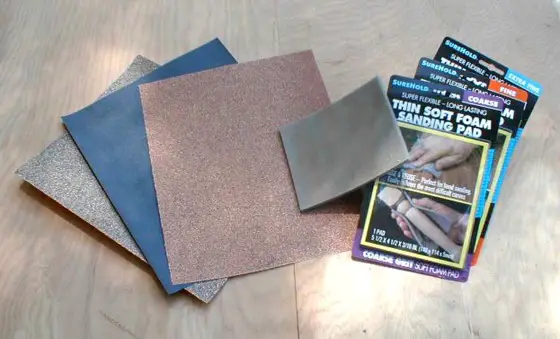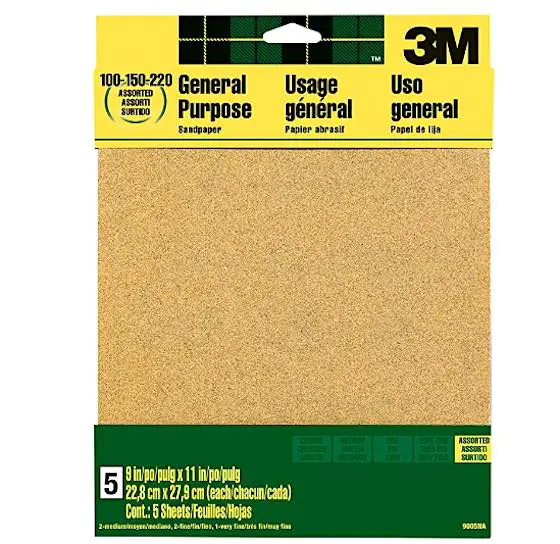Sandpaper Selection

Sandpaper Selection | This column was SO GOOD that I shared with the 31,000 subscribers who read my August 26, 2014 and my April 12, 2020 AsktheBuilder Newsletter. Photo Credit: Tim Carter
Sandpaper Selection
DEAR TIM: I could use a little help sanding some wood prior to staining it. I am sandpaper challenged. When I visit the hardware stores there are different colors, types, grits, etc. When do you use what? Is one paper better than another? I even saw some sandpaper on thin foam pads. It said on the package that you could rinse them with water after each use. Is that possible? Martin H., Sheperdsville, KY
DEAR MARTIN: You sure have some rough questions to answer. My answers may seem a little coarse, but I think they will be just fine. Okay, okay, so I won't quit my day job! The first thing you need to know is that they don't use sand on sandpaper. Today's manufacturers use high quality refined abrasive particles and fantastic resins and glues to bond the abrasives to a wide variety of different backing papers, foam and cloth.
Sandpaper got its start nearly 800 years ago. Chinese craftsmen used natural gum to bond crushed seashells to parchment paper. The abrasive paper industry continued to make progress but saw lots of innovation during the 1800's and early 1900's.
Most of the sandpaper products you see at the hardware stores are made using four types of abrasive particles, each available in different particle sizes or grits. The typical abrasive materials you will find are aluminum oxide, silicon carbide, red garnet, and ceramic grit.
Aluminum oxide sandpapers are probably the most common. They are excellent products to use on wood. One of the unique features of aluminum oxide is that it is a self-sharpening particle. As you use this type of sandpaper, small pieces of the grit fracture off. The remaining particle exposes a new sharp cutting face so that you see little loss of cutting power.

This is great aluminum oxide sandpaper. It's my favorite brand. CLICK or TAP HERE or the photo to have it delivered to you.
Silicon carbide is sharp as well, but it doesn't crack as easily as aluminum oxide. This property makes it an excellent abrasive for use on plastics and metal. Red garnet is an abrasive mineral that actually gets dull as you sand with it. At first blush this may seem like a disadvantage. Many wood workers like this quality because it allows them to highly polish and buff wood surfaces prior to the application of stains and clear finishes.
The ceramic grits are not as sharp as the others. These abrasive particles are usually found on sandpaper that is used with mechanical sanders such as large drum sanders, belt sanders and rotating disk sanders.
Just about every sandpaper you see on the shelf at the hardware store does a great job if you match it to the job you are doing. Keep in mind that to make a rough piece of lumber satin smooth before you stain it, you need to use possibly 4 different types of sandpaper. A coarse paper will often be a number 50 or 60 grit. Use this paper to begin the sanding process and sand across the grain of the wood or at a 45 degree angle to the grain. Switch next to 100 grit paper and sand in the same direction of the wood grain. The final sanding should be done with 150 or 180 grit paper just before you get ready to stain. Be sure to sand in the same direction of the grain with fine and ultra fine grits. After the wood has been stained you may want to lightly dress it with 220 grit paper before and in between coats of clear urethane. If you desire professional results, the wood needs to be as smooth as glass before you stain.
The sandpaper coated foam pads are really innovative. Most are made to be used wet or dry. This means you can use them for wood, metal or plastic. The foam actually helps the sanding process as it allows the grit to float over the object being sanded. This usually produces a more gentle and more even cut. Because the foam is flexible, the pads allow you to easily sand rounded or irregular shaped objects. I have used them with great success and love the fact that you can clean and rinse them after each use. Once dry, the foam sanding pads look and perform like new.
Companion Articles: Sandpaper Comparison, Foam Pads for Sanding, Abrasives & Specialty Sandpaper, Sandpaper Facts
This popular article was the Tip of the Week in the June 4, 2013 AsktheBuilder Newsletter.
Column 281
4 Responses to Sandpaper Selection